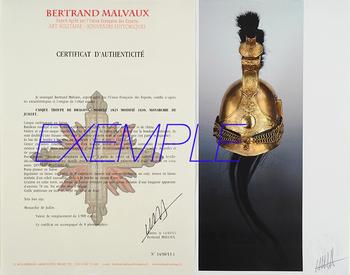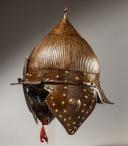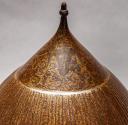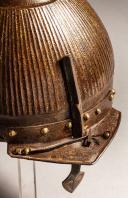
Bourguignon with Oriental inspiration (zischägge) Southern Germany (probably Nuremberg), c. 1560-70. PHILIPPE MISSILLIER COLLECTION, Giquello Study, Drouot - rooms 5-6, March 6-7, 2025.
Sold out
PHILIPPE MISSILLIER COLLECTION
EARLY PERIOD – BOOKS – 17TH CENTURY FIREARMS
HUNTING ART – PHALERISTICS
18TH AND 19TH CENTURY WEAPONS – RUSSIAN ART
Friday, March 7, 2025 - 11am to 12pm
AFRICA AND OCEANIA – FAR EAST
Friday, March 7, 2025 - 2pm
ISLAMIC AND INDIAN ART
Drouot - rooms 5-6
EXHIBITION
Tuesday, March 4, from 11am to 6pm
Wednesday, March 5, from 11am to 6pm
Thursday, March 6, from 11am to 12pm
Phone during the exhibition +33(0)1 48 00 20 05
GIQUELLO
Alexandre Giquello
Violette Stcherbatcheff
5, rue La Boétie - 75008 Paris
+33 (0)1 47 42 78 01 - info@giquello.net
With approval
No. 2002 389
CONTACT
Claire Richon
+33(0)1 47 70 48 00
c.richon@giquello.net
SPECIALIST
Marina Viallon
+33 (0)6 72 42 57 24
marina.viallon@yahoo.fr
Lot No. 70 (from the sale)
Oriental Bourguignotte helmet (zischägge)
Southern Germany (probably Nuremberg), c. 1560-70
H. 38 cm – W. 22 cm
341 CH
€100,000/120,000
Oriental Bourguignotte helmet (zischägge) in iron, composed of a high conical bulging top with a point, with fine grooves framed at the top and bottom by smooth sections. The piece retains its two articulated cheek pieces, each adorned with an almond-shaped bulge pierced with holes, its pointed nape guard with two blades, and its pointed visor, the spring mechanism of which allows for the maintenance and adjustment of the height of the large nasal guard. The nasal guard, of triangular section ending with a leaf-shaped extremity adorned with silver motifs, is not original but belongs nonetheless to the period of helmet use. The entire outer surface is gilded and engraved with acid-etched decoration mainly consisting of variously dense vegetal scrolls on a dotted background. Around the top of the helmet, on the smooth part, the vegetal decoration accompanies two bovine heads, finely detailed, with their horns connected by bands of fabric. Rivets with brass-covered heads hold the plates together and secured the internal padding (with a fragment of red fabric still attached to one of the cheek pieces). Such zischägges, inspired by Ottoman helmet models, were produced in the major workshops of southern Germany mainly for the markets of Central and Eastern Europe. The style of acid-etched decoration is characteristic of these production centers, particularly Augsburg and Nuremberg, and is found at the same time on their more "Western" pieces. However, what makes this particular example exceptionally rare, besides its excellent state of preservation, is the presence of the two bovine heads engraved at the top. Typically, zischägges feature aniconic decoration, solely geometric or vegetal, following the tradition of Islamic weapons. These bovine heads are certainly related to the famous emblem of Wieniawa, the clan bison head from Moravia, adopted during the Middle Ages in the heraldry of numerous prominent families of Central Europe, especially in Poland. Therefore, this helmet was most likely made for one of their distinguished members. While some other fine specimens of similar zischägges are known, such as at the Wallace Collection in London (A104) or the Metropolitan Museum of Art (2014.758 and 04.3.216), the one presented here is the only one to our knowledge with any kind of personal, especially figurative heraldic design. Good condition, slightly worn gilding, nasal guard replaced in an earlier period requiring the removal of the original iron strap loops which still remain on the front of the helmet, hinge, surface covered with a preserving varnish.
EARLY PERIOD – BOOKS – 17TH CENTURY FIREARMS
HUNTING ART – PHALERISTICS
18TH AND 19TH CENTURY WEAPONS – RUSSIAN ART
Friday, March 7, 2025 - 11am to 12pm
AFRICA AND OCEANIA – FAR EAST
Friday, March 7, 2025 - 2pm
ISLAMIC AND INDIAN ART
Drouot - rooms 5-6
EXHIBITION
Tuesday, March 4, from 11am to 6pm
Wednesday, March 5, from 11am to 6pm
Thursday, March 6, from 11am to 12pm
Phone during the exhibition +33(0)1 48 00 20 05
GIQUELLO
Alexandre Giquello
Violette Stcherbatcheff
5, rue La Boétie - 75008 Paris
+33 (0)1 47 42 78 01 - info@giquello.net
With approval
No. 2002 389
CONTACT
Claire Richon
+33(0)1 47 70 48 00
c.richon@giquello.net
SPECIALIST
Marina Viallon
+33 (0)6 72 42 57 24
marina.viallon@yahoo.fr
Lot No. 70 (from the sale)
Oriental Bourguignotte helmet (zischägge)
Southern Germany (probably Nuremberg), c. 1560-70
H. 38 cm – W. 22 cm
341 CH
€100,000/120,000
Oriental Bourguignotte helmet (zischägge) in iron, composed of a high conical bulging top with a point, with fine grooves framed at the top and bottom by smooth sections. The piece retains its two articulated cheek pieces, each adorned with an almond-shaped bulge pierced with holes, its pointed nape guard with two blades, and its pointed visor, the spring mechanism of which allows for the maintenance and adjustment of the height of the large nasal guard. The nasal guard, of triangular section ending with a leaf-shaped extremity adorned with silver motifs, is not original but belongs nonetheless to the period of helmet use. The entire outer surface is gilded and engraved with acid-etched decoration mainly consisting of variously dense vegetal scrolls on a dotted background. Around the top of the helmet, on the smooth part, the vegetal decoration accompanies two bovine heads, finely detailed, with their horns connected by bands of fabric. Rivets with brass-covered heads hold the plates together and secured the internal padding (with a fragment of red fabric still attached to one of the cheek pieces). Such zischägges, inspired by Ottoman helmet models, were produced in the major workshops of southern Germany mainly for the markets of Central and Eastern Europe. The style of acid-etched decoration is characteristic of these production centers, particularly Augsburg and Nuremberg, and is found at the same time on their more "Western" pieces. However, what makes this particular example exceptionally rare, besides its excellent state of preservation, is the presence of the two bovine heads engraved at the top. Typically, zischägges feature aniconic decoration, solely geometric or vegetal, following the tradition of Islamic weapons. These bovine heads are certainly related to the famous emblem of Wieniawa, the clan bison head from Moravia, adopted during the Middle Ages in the heraldry of numerous prominent families of Central Europe, especially in Poland. Therefore, this helmet was most likely made for one of their distinguished members. While some other fine specimens of similar zischägges are known, such as at the Wallace Collection in London (A104) or the Metropolitan Museum of Art (2014.758 and 04.3.216), the one presented here is the only one to our knowledge with any kind of personal, especially figurative heraldic design. Good condition, slightly worn gilding, nasal guard replaced in an earlier period requiring the removal of the original iron strap loops which still remain on the front of the helmet, hinge, surface covered with a preserving varnish.
Reference :
Étude Giquello, Drouot - salles 5-6, les 6 & 7 mars 2025

Next update Friday, april 4th at 1:30 PM
FOR ALL PURCHASES, PAYMENT IN MULTIPLE CHECKS POSSIBLE
bertrand.malvaux@wanadoo.fr 06 07 75 74 63
An authenticity certificate of the item including the description published on the site, the period, the sale price, accompanied by one or more color photographs is automatically provided for any item priced over 130 euros. Below this price, each certificate is charged 5 euros.
Only items sold by me are subject to an authenticity certificate, I do not provide any expert reports for items sold by third parties (colleagues or collectors).


